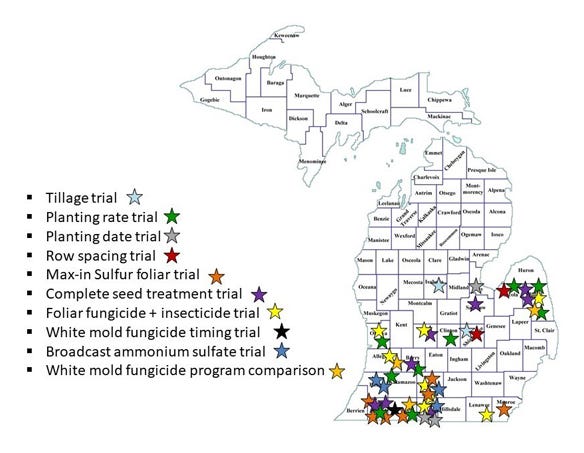December 27, 2019

By Michael Staton
The 2019 Michigan Soybean On-farm Research Report is now available online. The report will be mailed to 11,000 Michigan soybean producers in January, but the online version is the best way for agribusiness managers, sales representatives and agronomists to access the report, as it will be mailed to only Michigan soybean producers.
The report summarizes the results from 10 soybean projects conducted by Michigan State University Extension and the Michigan Soybean Checkoff, evaluating products and management practices having the potential to increase soybean yields and income.
Many of the projects were conducted at multiple sites in 2019 and some were conducted over multiple years. Thirty-six soybean producers conducted 47 individual on-farm trials in 2019. The trials fall within four categories: plant nutrition, pest management, seed treatments and planting rates.
Visit the Michigan Soybean On-farm Research page for links to each of the individual trials, as well as the full report.

All treatments were replicated at least four times in nearly all the trials to reduce the effect of field variability on the results. Proven statistical methods were used to determine if the treatments had a statistically significant effect on soybean yields. Finally, the effect that the treatments had on income was determined for each project.
One of the comments heard most often about past Michigan Soybean On-Farm Research reports is there is little or no difference in the yields produced by the treatments and the untreated control in some of the trials (no magic bullet was found). This is the case for some of the products evaluated in 2019.
However, this is still valuable information, as there are two ways to increase income: increasing yields and reducing costs. If the new treatment does not perform significantly better than the untreated control when evaluated across multiple locations and over several years, producers may be able to save money and increase income by not using the product or management practice.
The research report was a team effort. However, contact Michael Staton at 269-673-0370, ext. 2562, or [email protected] if you have questions or comments regarding the report.
For information, visit extension.msu.edu. To contact an expert in your area, visit canr.msu.edu/outreach/experts or call 888-MSUE4MI (888-678-3464).
Staton is a soybean educator with MSU Extension.
Source: Michigan State University Extension, which is solely responsible for the information provided and is wholly owned by the source. Informa Business Media and all its subsidiaries are not responsible for any of the content contained in this information asset.
You May Also Like




